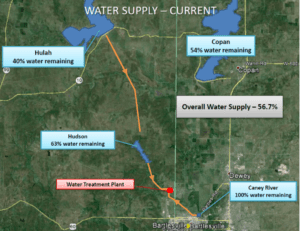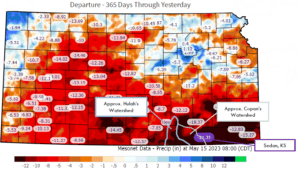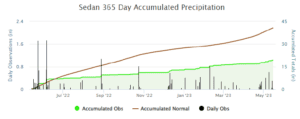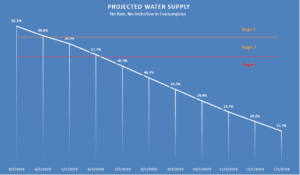 Overall water supply increased for the first time in nearly a year last week — thanks to recent rains in Southeast Kansas, where the watersheds for Hulah and Copan lakes are located.
Overall water supply increased for the first time in nearly a year last week — thanks to recent rains in Southeast Kansas, where the watersheds for Hulah and Copan lakes are located.
But unfortunately, the increase isn’t enough to move the needle in Bartlesville’s drought situation, Director of Water Utilities Terry Lauritsen said this week.
“While the rains last week have not had a big impact on lake levels, we do have our first increase in water supply since last summer,” Lauritsen said. “Our water supply is currently at 56.2 percent, compared to 56.1 percent the week before. While this doesn’t solve our problems, as we are still under Stage 3 water restrictions, it does slow the progression of decline and is a step in the right direction, and that is always good news.”
Stages of the Water Shortage Ordinance are based on the percentage of overall water supply. Stage 1 kicks in when levels fall to 79-70 percent, Stage 2 is 69-60 percent, Stage 3 is 59-50 percent, and Stage 4, which is considered “critical,” is any level below 50 percent. The City entered Stage 1 of the ordinance in December 2022, and overall water supply has continued to decline at a steady rate since that time, with the exception of last week.
The area is currently under Stage 3 water restrictions as outlined in the Water Shortage Ordinance. Stage 3 restrictions limit outdoor water use to one day per week and imposes fines for violations. Additionally, the City Council on Monday voted to approve implementing Stage 3 emergency water rates, which will apply to households using 2,001 or more gallons of water per month. Stage 3 rates will affect 6,600 of the total 13,600 water customers, 7,000 of whom will not be affected.
“Emergency rate increases are intended to get people’s attention and promote conservation but not be overly punitive,” Lauritsen said. “For instance, if I use 25,000 gallons of water, which is about four times the volume that an average family would use, my bill, with the Stage 3 emergency water rates, is going to go up $9.
“For average water consumption of 6,000 gallons per month, the bill will go up 88 cents. If a family that averages 6,000 gallons of water use a month is able to reduce their consumption by a 1,000 gallons a month, their water bill will go down, even with the emergency water rates.”
In other good news, daily consumption declined last week in comparison to the previous week, Lauritsen said.
“We used 4.38 million gallons per day (mgd) last week, which is down from 4.69 mgd the week before,” he said. “The decline is likely due to a reduction in outdoor water use because of the rain, in addition to increased water rates for high-use households.”
Despite supply holding steady last week, a lot of rain is still needed in Southeast Kansas to fill Hulah and Copan lakes and bring the City’s overall water supply back up to normal, Lauritsen said.
“Over the last year, Hulah and Copan’s watershed is down from approximately 12 inches to more than 21 inches of normal rainfall,” he said. “Year to date, we’re six inches below what is normally received. Over the last two weeks, we’ve received around 1.4 inches less than what is normal. The rains last week have helped, but we’re not even at normal rainfall for the last two weeks. We need a lot more rain to start seeing runoff get to the lakes.”
Projections
Lauritsen said without enough measurable rainfall to change the picture, the City is projected to move to Stage 4 in June and could run out of water entirely as early as January 2024.
“We will likely move to Stage 4, the last stage in our ordinance and what we would consider ‘critical,’ in June,” he said. “I think with the rains we’ve had recently we might have moved that back to mid to late June, but unless we get sizable rains, we’re still heading toward a June threshold for being within Stage 4 water restrictions.”
Lauritsen said City staff will likely recommend that the City Council consider more extreme conservation measures for heavy water users at that time.
“I suspect if we get to the 50 percent threshold we will probably look at making modifications to the ordinance to try to target these outliers, or heavier water users, in an effort to help preserve what water is left,” he said.
Without intervention, the City is likely to run out of water early next year.
“Without rain and/or major reduction in consumption between now and then, we are targeted to be at roughly 15 percent in overall supply by January 2024,” he said. “This is about where we were during the drought of 2001-02, so this would be a very serious situation for us.”
What to do right now
The following provisions are in effect for all City of Bartlesville water customers:
- Rates increases for customers using more than 2,000 gallons of water per month.
- 2,001 gallons to 10,000 gallons – 5 percent increase
- 10,001 gallons to 25,000 gallons – 10 percent increase
- 25,001 to 50,000 gallons — 15 percent increase
- In excess of 50,000 gallons – 20 percent increase
- Outdoor water is restricted to one day per week (Violations could result in a fine of $50 for the first offense up to $500 for the fifth or more offense.)
- Even-numbered properties may water on Thursdays
- Odd-numbered properties may water on Friday
- Water pressure has been reduced within the distribution system to minimum levels allowed by state and federal regulations
To see the full list, see www.cityofbartlesville.org or Water Shortage Ordinance.
Note: A variance committee is in place to consider cases of undue hardship for the emergency rates only and does not apply to outdoor water use. To apply for a variance, complete the “Contact Us” form on the City’s website, www.cityofbartlesville.org, or call 918.338.4100.


